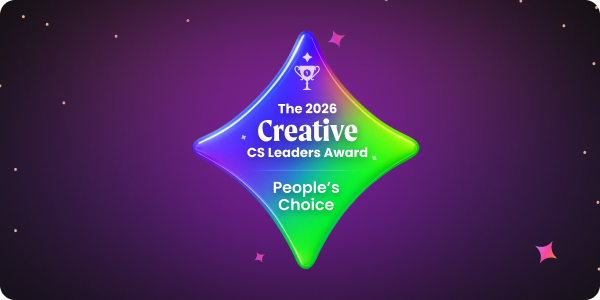Customer Success Managers are here to ensure that each success plan is aligned and working for the benefit of each customer. Once the plan is created and effectively aligned, it will be key to driving customer outcomes throughout the customer journey. It will also evolve as the desired outcomes of your customer evolve. To put it simply, success plans act as the North Star for your CSMs as they help your customers achieve success every step along their journey.
So how do you get started with creating a success plan? Does every plan have to look completely different since you’re creating one for each customer? How often should they change?
These are questions many CS leaders ask when starting out. If you’re asking these kinds of questions, you’re in the right place.

What You Can Expect To Learn
- How to lay the foundation of an effective CS plan
- What makes up an effective CS plan
- How to engage with your customers throughout their journey
- Using your CS plan to build long-term relationships with your customers
- Technology platforms that can help
Having a Plan: The Foundation of Long-Term Customer Success
Customer Success, when done correctly, isn’t just a department; it’s a company-wide mindset. If CSMs want to build a more customer-centric culture within their organization, they need to start with themselves and the personal relationships they have with their customers.
The first step to building these personal, long-lasting relationships is to ensure you’re on the same page with your customers. Creating a CS plan will not only help your CSMs be on the same page with your clients but also allow them to create better internal relationships within your organization. This is because they will have data showing exactly what needs to be done to ensure customers are successful.
Customer Success planning all starts with knowing what your customer’s goals are. Once you know that, you will have a solid foundation for a Customer Success plan. Each plan will be tailored to your individual customers but can all have a similar layout or blueprint.
For example, each success plan can answer similar questions such as:
- Why did they buy your product or service in the first place?
- What current projects are they working on?
- What major concerns do they currently have?
- What does success with your product or service look like to them?
These are subject to change but that’s the point of an effective CS plan. It evolves as your customers evolve.
Don’t try to overcomplicate it too much. As long as you know what their goals are and are able to determine what key questions you want answered, you will have a solid foundation that will move your customers through their journey successfully.
Building Blocks of an Effective Customer Success Plan
.avif)
An effective Customer Success plan guides your customers through their journey with your product. More importantly, it brings the needed data and intel your CSMs need to make every customer interaction valuable. Now that you know how to set a foundation, here are key components to include when building an even more effective success plan:
Customer Success Objectives
Clear, measurable goals aligned with your customer's business objectives are needed for any effective CS plan. Whether it's increasing user adoption, improving customer retention, or improving product value, your objectives should be the following:
- Specific
- Measurable
- Attainable
- Relevant
- Time-bound
(Think SMART)
You can also view this as what your customers desired outcomes are and how they align with what your product or service offers. This alignment will give you the key objectives to include in your plan.
Segmentation and Personalization
Not all customers are the same. Segment your customer base by size, industry, or usage patterns to tailor your approach. Personalization improves the customer experience, making your strategies more impactful.
Using AI-powered tools like Optimove and Segment to segment your customers gives Customer Success teams the ability to use these segments to personalize their approach with each customer.
Success Milestones
Identify key milestones in the customer journey. These could include onboarding completion, first value realization, and achievement of specific business outcomes. Milestones help track progress and ensure alignment with the success plan.
Risk Management
Implement a system to identify and address risks early. This could involve monitoring usage data to spot declining engagement or setting up alerts for customer health scores. Having this knowledge will help your CSMs know what areas of the success plan need to be evaluated and updated if necessary.
Proactive Customer Engagement Strategies
Proactivity is the foundation of all Customer Success strategies. Every Customer Success process is dependent on how proactive Customer Success Managers are with their customers. Here are strategies that will keep you proactive in your approach to customer relationships:
Provide Educational Content
When designing a success plan, make sure it involves continuously educating your customers. Customers who are educated usually stay engaged and, as a result, become long-term customers. Provide resources like tutorials, webinars, and guides that help customers maximize the value of your product.
At EverAfter, we do our best to provide different types of resources like webinars and ebooks so our customers know exactly how to achieve their desired outcomes. You can see all the resources we provide Here.
Get a Meeting Cadence Scheduled
Stop “checking in” with your clients.
Every interaction should bring value to your customers. This is why success plans are so important. CSMs have data to refer to when they speak with customers so each call is valuable. Schedule periodic meetings to discuss goals, challenges, and feedback. These valuable touchpoints are crucial for relationship building as well as identifying upsell or cross-sell opportunities.
Customer Success Platforms
Utilize software that offers real-time insights into customer health. The great thing about our current time is that there is an abundance of tools that specialize in different aspects of the customer journey. EverAfter provides a seamless experience for Customer Success teams to build out individualized CS plans. Tools like HubSpot Service Hub and Zendesk offer innovative ways to track and interpret customer health scores.
Take the time to analyze what your customers need and what tools are available that will your team meet the needs of your customers. The tech stack you use can be your greatest asset to creating a success plan to truly drive your customers to action and success.
Building Strong Customer Relationships
The strength of customer relationships directly impacts retention and growth. Strengthening customer relationships should be the reason any CS team creates a success plan in the first place. These relationships also affect every Customer Success process you have in place.
A quality success plan should prioritize these aspects of relationship building:
- Empathy and Understanding: Always approach interactions with empathy. Understanding your customers' perspectives fosters trust and loyalty.
- Transparent Communication: Be honest about what your product can and cannot do. Setting realistic expectations prevents future disappointments.
- Community Building: Create forums or user groups where customers can share experiences, challenges, and successes. This not only provides valuable feedback but also strengthens the customer community.
Leveraging Technology in Customer Success
Technology plays an important role in scaling Customer Success efforts. Creating a quality CS plan can also be streamlined and implemented quickly with the help of certain technologies.
Consider using any of these tools:
Customer Success Management (CSM) Platforms
These platforms provide a 360-degree view of customer health, facilitate workflow automation, and enable personalized engagement at scale. Gainsight is a great example of a tool that larger teams handling enterprise-level clients will find a lot of value in. While tools like Catalyst and ClientSuccess are the perfect match for small teams that handle SMB and mid-market clients.
Analytics and AI
Customer Success planning has been simplified by the era of AI. Use this to your team's advantage when it comes to creating quality success plans. Use analytics to get insights from customer data and AI to predict customer behavior and needs. Intercom is a great example of this. It provides AI-generated, proactive support that predicts customer needs. A tool like this in your toolbox will greatly improve your ability to adjust your success plan to fit the changing needs of your customers.
Integration Tools
Make sure your Customer Success tools integrate seamlessly with other business systems (CRM, support, marketing) so your customer data can live in one place. This will make the lives of your CSMs much easier. Tableau and MuleSoft are two tools that help teams around the world integrate their customer data and make it easter to interpret.
Conclusion
Your Customer Success roadmap should begin with your customers and their desired outcomes. Knowing exactly what their desired outcomes are means you know what success looks like to them. Building your Customer Success plan off of this knowledge will set your CSMs up for success when building long-term relationships with your customers. Your customers will be better off thanks to the time you took to build a success plan with them. And because of this, your organization will grow.

.avif)

.png)

.png)




%20(1).png)
















.png)
.png)
.png)



.avif)





.png)
.png)







